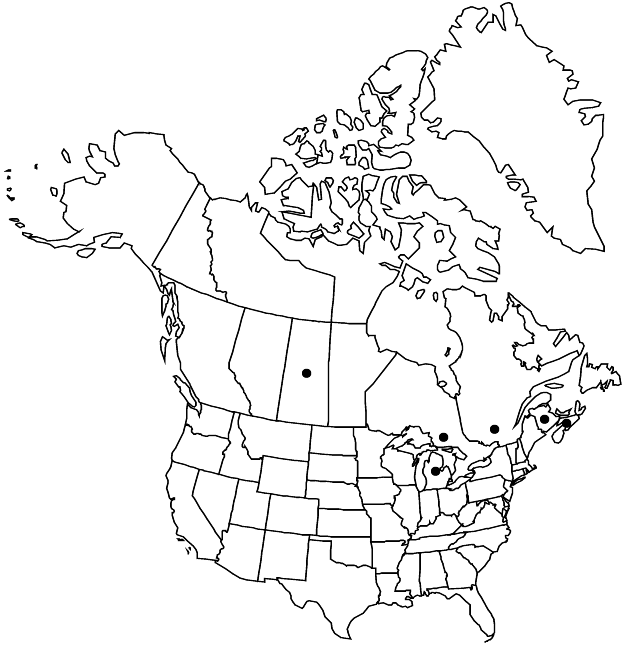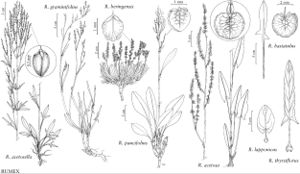Rumex thyrsiflorus
Linnaea 4: 380. 1829.
Plants perennial, glabrous or nearly so, with thick, vertical or oblique rootstock (reaching deep into substrate) and remote 2d-order roots. Stems usually erect, several from base, or occasionally solitary, branched in distal 1/2 (in inflorescence), (30–) 40–100 (–130) cm. Leaves: ocrea often with fringed margins; blade oblong-lanceolate to lanceolate, 3–12 (–15) × 1–3 (–5) cm, usually more than 4 times as long as wide, base sagittate or sometimes hastate (with acute lobes directed downward, ± parallel to petiole, or often reflexed outward), margins entire to obscurely and irregularly repand, usually crisped and undulate, occasionally flat, apex acute. Inflorescences terminal, occupying distal 1/3 of stem, usually dense, or interrupted in proximal part, broadly paniculate, pyramidal (1st-order branches usually repeatedly branched, with numerous 2d-order branches). Pedicels articulated near middle, filiform, 2–6 (–7) mm, articulation distinct. Flowers (3–) 4–8 (–12) in whorls; inner tepals orbiculate, occasionally broadly ovate, 2.5–3.5 (–4) × 2.5–3.5 mm, base rounded, truncate, or slightly cordate, apex obtuse; tubercles small or occasionally absent. Achenes black or dark-brown, 1.5–1.8 × 0.8–1.2 mm, normally smooth. 2n = 14 (pistillate plants), 15 (staminate plants).
Phenology: Flowering late spring–early summer.
Habitat: Meadows, alluvial habitats, waste places, roadsides, edges of woods
Elevation: 0-1400 m (in Europe)
Distribution

Introduced; N.B., N.S., Ont., Que., Sask., Mich., c, e Europe, c Asia (s Siberia), elsewhere
Discussion
Rumex thyrsiflorus is commonly misidentified as R. acetosa. The growth habit (stout, vertical rootstock), narrower, often undulate leaves with often slightly spreading basal lobes (however, some European specimens have the lobes of distal and middle cauline leaves curved inward), and pyramidal, usually much-branched panicle of R. thyrsiflorus are traits especially useful for field identification. In addition, the inner tepals of R. thyrsiflorus are distinctly smaller than those of R. acetosa. The southern European (Mediterranean) race of R. thyrsiflorus, characterized by narrower leaves with more spreading, almost hastate basal lobes and fruiting inner tepals less cordate at the base, is sometimes recognized as R. intermedius de Candolle [= Acetosa thyrsiflora subsp. intermedia (de Candolle) Á. Löve]. The same forms occasionally occur in North America (Á. Löve 1986).
Selected References
None.
Lower Taxa
"/2" is not declared as a valid unit of measurement for this property.
